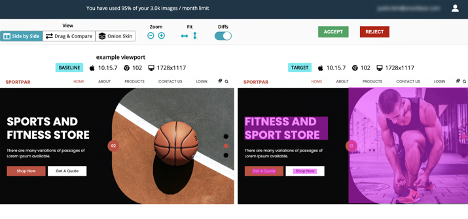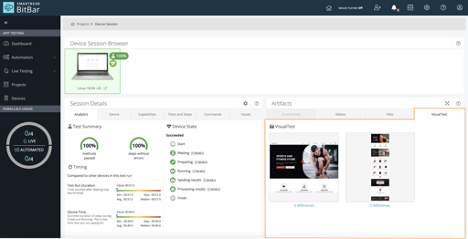Visual appearance is the first thing users notice when visiting a website or mobile app – before reading content or interacting with any elements. In fact, TopTal found that 94% of first impressions are design-related and judgements on a website’s credibility are 75% based on its overall aesthetics. So, even the slightest discrepancy could cost you sign-ups or conversions.
Most businesses already have functional and performance tests, but these don’t guarantee a flawless visual appearance. While visual testing may seem difficult to include in day-to-day testing, they’re essential to avoid making a bad first impression.
Visual tests can help you spot visual regressions between releases. By comparing each new release against a baseline, SDETs can spot regressions that may result in a bad UI or UX, such as layout issues, inconsistent styling, or broken images, before users see them.
This article will examine the most common methodologies for running visual regression tests and how to choose the best option.
What Are the Different Methodologies for Running Visual Regression Tests?
Manual Tests
Manual visual regression testing involves human QA teams combing through a UI to spot visible defects. For example, a QA team member might pull up the current and new releases side-by-side and manually scroll through each page. In addition, they may need to run these tests on multiple devices to get accurate results.
Pros
- No implementation is required.
Cons
- Extremely time-consuming and costly since it takes time out of a QA's day to run these tests properly.
- Impossible to get complete coverage for every release since websites and apps update frequently.
- Imperfect because QAs cannot guarantee they've caught every possible visual defect.
Tldr; Manual testing just isn’t practical in today's fast-paced world.
DOM-Based Tests
DOM-based tests use the Document Object Model (DOM) to flag visual discrepancies. In particular, they take a snapshot of the DOM for a baseline and compare it to a new release. Since they are code-based comparisons, DOM-based visual tests are high-speed and efficient. However, not every visual regression appears in the DOM.
DOM-based tests only verify that you’ve applied the correct styles to an element. So, for example, a `.heading` class might appear correctly for a section’s `h1` tag, but if designers accidentally set the `.heading` class to have a small font size, they wouldn’t catch it.
Pros
- Compares many critical UI elements without also counting false positives.
Cons
- Doesn’t compare all elements that make up your UI (e.g. iframe)
- Identical DOM structures can render differently.
- Different DOM structures can render similarly.
- They don't see what the eye sees exactly.
Tldr; DOM-based tests are very efficient but don't guarantee accurate results and miss other elements of the UI
Pixel-by-Pixel Tests
Pixel-by-pixel tests take screenshots of a baseline and new release and compare them, pixel-by-pixel, to spot visual regressions. Since they analyze what users actually see and spot every change, they can spot details down to the font size, color, and layout. However, they require more computational power and may throw false positives (expected changes that occur across releases).
While some pixel-based screenshot comparison tools typically use a threshold percentage to filter results, this approach is somewhat arbitrary since some small changes could significantly impact the user experience and vice-versa.
Pros
- Pixel-by-pixel tests are better than the human eye and can help you better guarantee quality.
Cons
- Spotting every change often translates to more false positives
- Adds to your workload and the time it takes to review all of your work
Tldr; Pixel-by-pixel tests provide the most accurate results but may cost you time and effort to review false positives.
AI-Based Tests
AI-based tests leverage machine learning and artificial intelligence to identify visual discrepancies. For example, they may use neural networks to learn the visual elements of a website or app and compare them to a baseline version. But unlike pixel-by-pixel tests, they won't necessarily flag changes that don't matter (such as copy differences).
Pros
- Saves time and makes it easier to review by only highlighting relevant changes.
- Enables more test coverage by producing fewer false negatives.
Tldr; AI-based tests provide an ideal blend of accuracy and discretion to flag discrepancies that matter.
Why You Should Choose AI Over...
- Manual Tests – Manual testing quickly becomes impractical as an application becomes more complex and releases become more frequent. AI-based tests are much more scalable.
- DOM-based Tests – DOM-based tests efficiently compare DOMs but miss crucial visual elements. AI-based tests go further by looking at what users see on the screen.
- Pixel-by-Pixel Tests – Pixel-by-pixel tests spot every visual difference but require sorting through numerous irrelevant changes. AI-based tests can help filter out changes that don't matter.
How to Deploy AI-Based Tests
VisualTest makes it easy to deploy AI-based visual tests without manually taking screenshots or dealing with machine learning models. That way, you can focus on building your website or application without worrying about maintaining QA or adding time-consuming steps to your existing QA processes – all saving you both time and money.

VisualTest makes it easy for anyone to assess visual regressions. Source: VisualTest
By adding the VisualTest code snippets to your existing tests, you can automatically start comparing baseline images while simultaneously reducing your assertion code bloat. You can view the outputs by going to the links in the logs or signing in to the VisualTest platform to accept or reject changes. And with cloud-side execution, you don't have to worry about installing anything that interferes with your existing test suites.

BitBar makes running tests on real devices and browsers easy for the most accurate QA results. Source: SmartBear
VisualTest also integrates with BitBar to run tests on real browsers and devices rather than emulators or building your own costly device lab. That way, you can more accurately identify potential problems on user devices. And at the same time, you can use BitBar's cloud-based devices to reproduce and troubleshoot any errors.
The Bottom Line
Visual tests are essential to ensure a robust user experience and prevent costly errors. While there are many ways to implement visual tests, AI-based tests provide an ideal blend of accuracy and discretion – flagging the issues that matter most. They're the best way to ensure a robust user experience without wasting time and money on false positives.
VisualTest uses AI and machine learning models so you can quickly compare visual differences at scale with confidence. Start your free trial today!